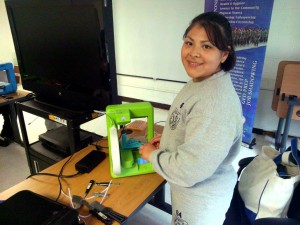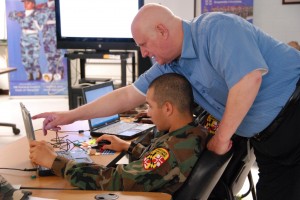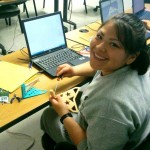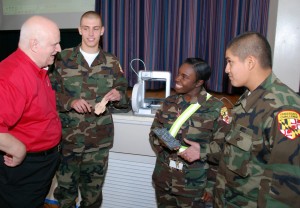
The 3D printing classes YouthQuest Foundation Training Director Tom Meeks teaches are truly multi-dimensional. While his students work on understanding the science and math of additive manufacturing, they also learn lessons in life.
During one recent session, Cadets from Freestate and Capital Guardian ChalleNGe Academies were creating sets of gears when the subject suddenly shifted to Thomas Edison’s invention of the light bulb.
Tom told the class that Edison – who was once labeled “too stupid to learn anything” by a teacher – built about 1,000 unsuccessful prototypes before finally making a bulb that worked. When a reporter asked how it felt to fail 1,000 times, Edison replied: “I didn’t fail 1,000 times. The light bulb was an invention with 1,000 steps.”
The story resonated with the Cadets, most of whom had failed in school and dropped out. They realized that quitting high school was a mistake and they enrolled in the National Guard Youth ChalleNGe Program to change their lives by resuming their education.
Step by step, YouthQuest’s 3D ThinkLink Initiative is showing at-risk teens that mistakes are opportunities to learn and improve.
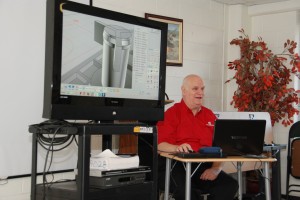
Instructors at Maryland’s Freestate and Capital Guardian, serving the District of Columbia, choose promising Cadets to take part in the 3D ThinkLink Initiative, which YouthQuest sponsors to support STEM (Science, Technology, Engineering, Math) education.
“It’s really important to the YouthQuest mission that we not just do 3D printing as an end in itself. It’s got to be integrated into what the students are learning,” explained Tom.
For example, the Cadets used math concepts such as ratios in designing their gears with Moment of Inspiration software. They also had to apply physics and engineering principles to make sure the parts would work together correctly after being fabricated by a Cube 3D printer.
“Is this stuff easy? No,” Tom told a class as some Cadets stumbled through the gear-building steps. “Why were you chosen? Because you can do hard things. I know you can do it!”
‘Your Failures Are Not Final’
The first assignment for these students was to create a cookie cutter. The results ranged from nearly perfect to way, way off.
Instead of the planned star-shaped outline, a couple of objects came off the printer as solid blocks of plastic. Tom playfully declared the botched cookie cutters to be “cookie mashers” and said he was glad to see them because they helped make the most important point about these classes.
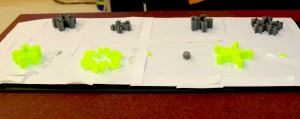
“Your failures are not final. You can redesign it and print it again.”
It’s a message Tom repeats frequently as he encourages the Cadets to work together and solve problems through creative thinking.
“It’s really a ‘thinking class’ more than a 3D printing class,” he said.
“We want them to learn to love learning. We want them to know that when they do fail, they can analyze that failure, study that failure, and then go on to make changes that make a positive result in their lives.”
‘These 3D Classes Are Awesome’
The project is a tremendous confidence-builder for Cadets, according to Keith Hammond, Manager of Information Systems at Capital Guardian and former Placement Coordinator at Freestate.
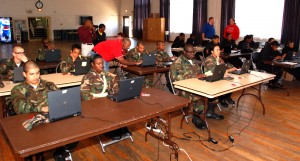
“They’ve gone from being the kids nobody wanted in class, who got kicked out of school,” said Keith, who has been deeply involved in the classes since the pilot project at Freestate early this year. “Now they’re in the top 1 percent of their student population because they know something that 99 percent of the kids do not know. They understand 3D printing – additive manufacturing – and they’ve been successful at it. So now they carry themselves with confidence in all their other classes.”
Freestate science instructor Timmy Jackson has seen Cadets who didn’t seem interested in academics at first become more engaged, thanks to the 3D ThinkLink Initiative. He recalled one in particular who started out as “maybe a C student in science.”
“Once he came to the 3D program, he became basically like an expert. He was actually giving some hints to the instructor,” he said.
“These 3D classes are awesome for the kids,” he added. “Some of them are already talking about this as a future. They want to know how they can get involved in it once they graduate.”
Keith has heard the same praise from other instructors at Freestate and Capital Guardian.
“They say, ‘Wow, the 3D kids are really stepping up their game now,’” he beamed. “So I can challenge them more and they’re not as frustrated when they fail because they’ve understood what Tom is teaching them: Failure can lead to success. It’s just one step.”
The Next Steps
YouthQuest has invited other National Guard Youth ChalleNGe programs in the mid-Atlantic region to start classes at their Academies early next year. Next summer, select students from all the programs will be invited to the Foundation’s headquarters in Chantilly, Va., for 40 hours of immersion training in the 3D ThinkLink Lab.
If you would like to make a contribution to keep this life-changing educational program growing, click here to donate or contact us at info@youthquestfoundation.org or (703) 234-4633.

